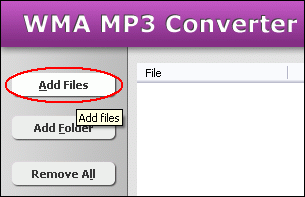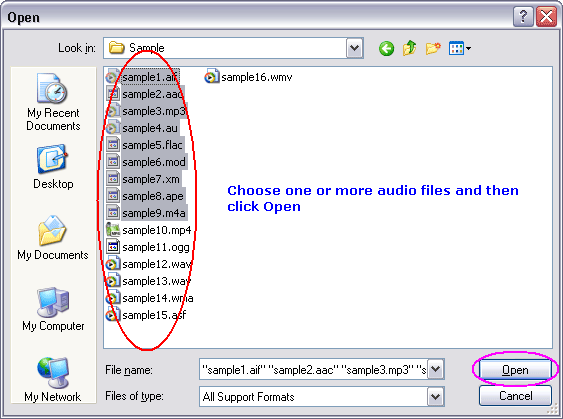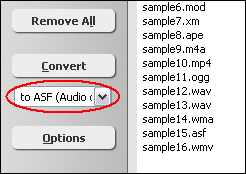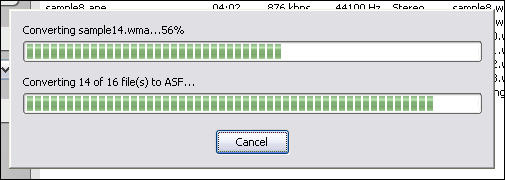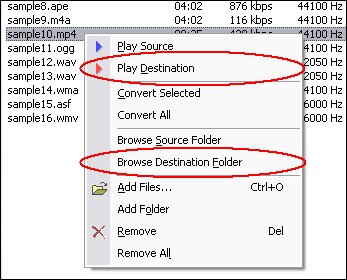WAV to ASFConvert WAV to ASF, WAV to ASF Converter |
 |
| Home | Getting Started | Download | Buy Now! | Screen Shots | FAQ | Support | Contact |
WAV to ASF Converter converts WAV to ASF. The software is an ALL-IN-ONE audio converter that supports more than 100 audio and video files. WAV to ASF Converter supports batch conversion and is full compatible with Vista and Windows 7.
What is WAV? Both WAVs and AIFFs are compatible with Windows, Macintosh, and Linux operating systems. The format takes into account some differences of the Intel CPU such as little-endian byte order. The RIFF format acts as a "wrapper" for various audio compression codecs. Though a WAV file can hold compressed audio, the most common WAV format contains uncompressed audio in the linear pulse code modulation (LPCM) format. The standard audio file format for CDs, for example, is LPCM-encoded, containing two channels of 44,100 samples per second, 16 bits per sample. Since LPCM uses an uncompressed storage method which keeps all the samples of an audio track, professional users or audio experts may use the WAV format for maximum audio quality. WAV audio can also be edited and manipulated with relative ease using software. The WAV format supports compressed audio, using, on Windows, the Audio Compression Manager. Any ACM codec can be used to compress a WAV file. The UI for Audio Compression Manager may be accessed through various programs that use it, including Sound Recorder in some versions of Windows. Beginning with Windows 2000, a WAVE_FORMAT_EXTENSIBLE header was defined which specifies multiple audio channel data along with speaker positions, eliminates ambiguity regarding sample types and container sizes in the standard WAV format and supports defining custom extensions to the format chunk. What is ASF? ASF is based on serialized objects which are essentially byte sequences identified by a GUID marker. The format does not specify how (i.e. with which codec) the video or audio should be encoded; it just specifies the structure of the video/audio stream. This is similar to the function performed by the QuickTime, AVI, or Ogg container formats. One of the objectives of ASF was to support playback from digital media servers, HTTP servers, and local storage devices such as hard disk drives. The most common filetypes contained within an ASF file are Windows Media Audio (WMA) and Windows Media Video (WMV). Note that the file extension abbreviations are different from the codecs which have the same name. Files containing only WMA audio can be named using a .WMA extension, and files of audio and video content may have the extension .WMV. Both may use the .ASF extension if desired. ASF files can also contain objects representing metadata, such as the artist, title, album and genre for an audio track, or the director of a video track, much like the ID3 tags of MP3 files. It supports scalable media types and stream prioritization; as such, it is a format optimized for streaming. The ASF container provides the framework for digital rights management in Windows Media Audio and Windows Media Video. An analysis of an older scheme used in WMA reveals that it is using a combination of elliptic curve cryptography key exchange, DES block cipher, a custom block cipher, RC4 stream cipher and the SHA-1 hashing function. ASF container-based media is usually streamed on the internet either through the MMS protocol or the RTSP protocol. WAV to ASF Related Topics: ALAW to ASF, EAC3 to ASF, RMI to ASF, NSA to ASF, SHN to ASF, AMR to ASF, UMX to ASF, VOC to ASF, WAVE64 to ASF, ADX to ASF, VQF to ASF, M4R to ASF, AC3 to ASF, S3M to ASF, OMA to ASF, AAC to ASF, MIDI to ASF, M4B to ASF, WAV to ASF, OGA to ASF, M2A to ASF, OGG to ASF, SOL to ASF, AWB to ASF, AIFC to ASF, CD to ASF, DTS to ASF, SPX to ASF, AU to ASF
|
| Home | Getting Started | Download | Buy Now! | Screen Shots | FAQ | Support | Contact | Links |
| Copyright © 2007-2014 Hoo Technologies All rights reserved. Privacy Policy |
